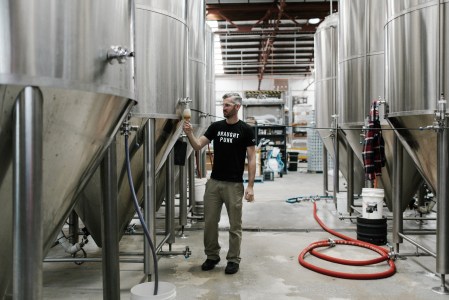
With our Winter issue landing in mailboxes around the country shortly, we’ve decided to revisit an insightful article from our recent Autumn edition – in which we discovered what it’s like to spend a day as a professional brewer.
A few months ago, we received an email from a reader who was considering a role in the brewing industry and was keen to find out more about what it all entailed. So, we asked some brewers to take us through their average day.
The first thing we discovered is that there is no such thing as an average day for a brewer. There is always something different going on, and inevitably something unexpected will happen that needs immediate attention. In the view of Ashley Hazell, head of brewing at Colonial Leisure Group, it is all about time management.
“You’re always doing a couple of things at once and managing your time,” he says. “Most things you do in a brewery you’re sort of waiting for. In the brewhouse if you mash in, you’ve got an hour before you can do anything to that batch, so you’re preparing for the next one. You might go away and weigh the next malt grist or if it’s brewing once, you’ll be the one doing the gravities and the filtrations as well because there isn’t much physical work to do during these steps. You try to do as much as you can at once. It’s about managing your time.”
Brewing is a process and thus brewers expect to start each day diving in at whatever stage of that process the beer is at – or even at two different stages on two different batches. This can mean starting a cycle from scratch or arriving at a point when there is nothing that actually needs doing to the batch. However, even then there are checks to be done on pH and gravity, equipment that needs to be cleaned, faults to be fixed and damages to be repaired.
Brewing might appear to involve a lot of waiting for the equipment and ingredients to do their thing, but actually a brewer’s work is never done, especially in a smaller operation. Beyond that, there is always the chance that something could go wrong and when this happens, the usefulness of skills outside brewing can become enormously apparent.
“There are systems, but it’s when things go outside those systems that’s usually when I get involved in the day to day, if something is horribly broken and we need everyone on deck to troubleshoot,” says Hazell. “I hired a plumber a few months ago which was probably one of the best things I ever did.”
In recent years, brewing has evolved from more than a hobby into a considerably desirable career choice. More and more universities are offering qualifications that cater for the increasing number of people looking to get into the industry. Hazell can see why: it’s a fun industry, even if it is a lot of hard work. However, before you start writing out applications to your local brewery, he has two key pieces of advice:
“It’s not going to be as much fun as it seems at first. You have to put in the hard yards, you have to do the hours, do the hard work to get recognised in the industry to be able to get into a job where you’re going to have enough influence in the brewery to do the fun stuff, which is designing beers.
“The other thing is you’ve got to have something to offer because it’s a very complex industry. Running a brewery and dealing with the challenges that are thrown at you day to day is very challenging and you’ve got to learn a lot. I’ve been in the game for 14 years now and I learn every single day and still have a lot to learn. For someone to teach you that, you have to have something to offer them as well.
“If you’ve got a trade or a background that’s relevant, it’s going to make it a lot easier to get into the industry. Or go and do some studying. Show your potential employer that you care, that you’re willing to back yourself, to perform in the industry rather than ‘hey I want a job, can you teach me everything you know and in return I’ll try not to fuck it up’.”
An average brew day with Murray Robinson, brewer at 3 Ravens
8am: Arrive at work and start mashing in as soon as possible. This includes ensuring the correct grain is ready to go based on the recipe card and brew schedule, checking the temperature of the grain to determine the strike temperature of the mash, and ensure my mash salts are ready to go. Mashing in takes about an hour depending on the recipe and needs to be constantly monitored as it goes in to ensure homogeneity and that the water going in is at a constant correct temperature. I also use mash in time to do any minor tank jobs which includes yeasting off tanks that have finished fermentation and checking the gravities, pH and VDK of any actively fermenting tanks.
9am: Once the mash-in is complete I check the volume of the mash, the temperature and the pH. Keeping records of every piece of information as we go is very important for brewing consistent beer and troubleshooting later if we need to. Once that is done I clean out the mill room, vacuuming up all the dust and lose grain, then load up the room for the next brew day. This is also a good time to check on what deliveries or pickups I can expect for the day and plan accordingly. The mash rest takes 45 minutes at the end of which I will start recirculating the mash.
10am: Once the mash recirc is running nice and clear (roughly 20 minutes) I will get the lauter started (running the wort to the kettle) and check the gravity and pH of the first runnings. Once the speed of the lauter and sparge water is dialled in, it runs fairly well by itself so this frees up some time for other jobs. The most important being that the tank I am brewing into is cleaned and sanitised and the transfer lines that will run from the kettle through our heat exchange and to the fermenter are also cleaned, sanitised and ready.
12pm: At the end of lauter, we start to homogenise the kettle and clean out the mash tun. Cleaning out the mash tun is a fairly physical job involving scrapping out all the grain and rounds of cleaning of hot flushes, caustic foaming and high pressure rinses. I am also getting out a sample from the kettle, cooling it down and checking the specifications to ensure it is in line with the recipe.
1pm: Boiling kicks off usually around this time and I need to ensure all kettle additions are ready to go. I’m usually still doing rounds of cleaning on the mash tun during this time.
2pm: Once the boil is finished we need to top up in the kettle to get the correct volume for our correct starting gravity. Most of our beers also receive the bulk of their hops during the whirlpool and at different temperatures so the kettle may need to be recirculated through the heat exchange to bring it down from boiling to 95 or 90°C. This ensures good flavour extraction from the whirlpool hops with low utilisation (or bittering). Once the hops are in, the kettle is whirlpooled for 10 minutes and then allowed to stand for a further 10 minutes to allow solids to form into a cone at the bottom of the kettle. After this we are good to start transferring into the fermenter. During transfer we need to get other products into the tank; some beers are dry hopped at this point, some beers require the addition of brewers clarex or fermenter antifoam and as the wort is going in all beers require the yeast to be pitched.
3pm: Once the transfer is done, the lines are flushed with hot water and recirculated with caustic, the kettle is emptied and rounds of hot water, caustic and high pressure cleaning ensues, and the wort that is in tank is sampled to make sure it fits the specifications. Cleaning the kettle, lines, packing down and cleaning down the brewery floor takes all up about an hour.
4pm: Brewery day done!
For more articles like this one, subscribe to Beer & Brewer here.
